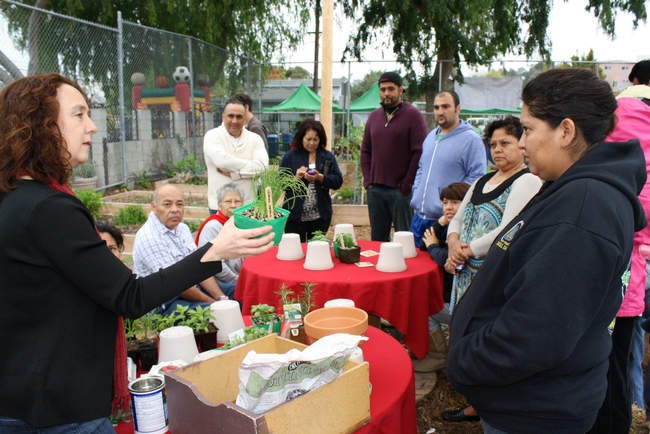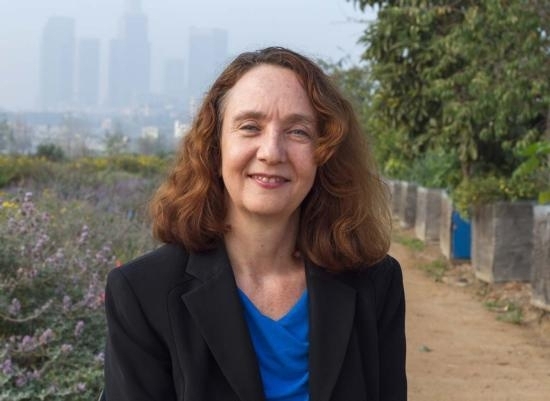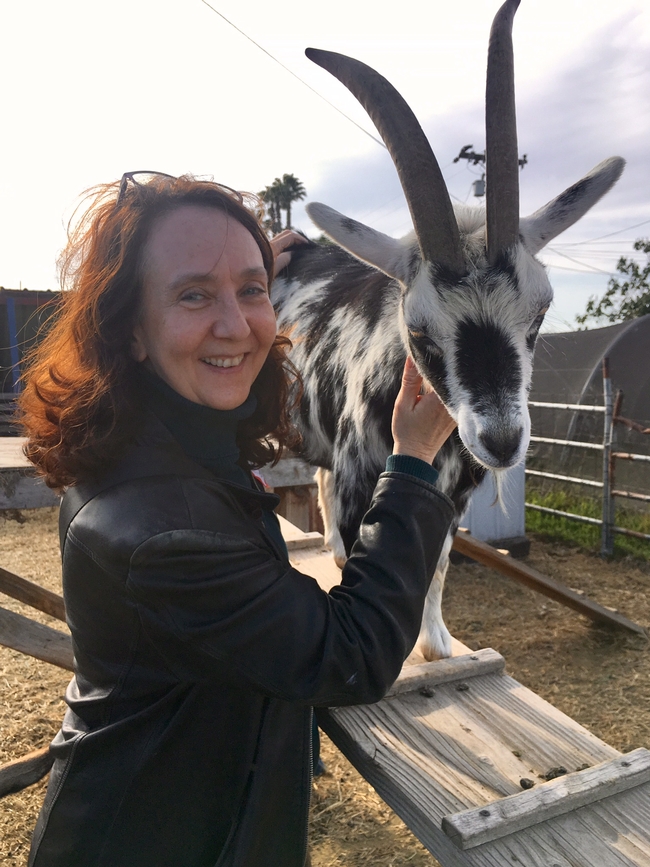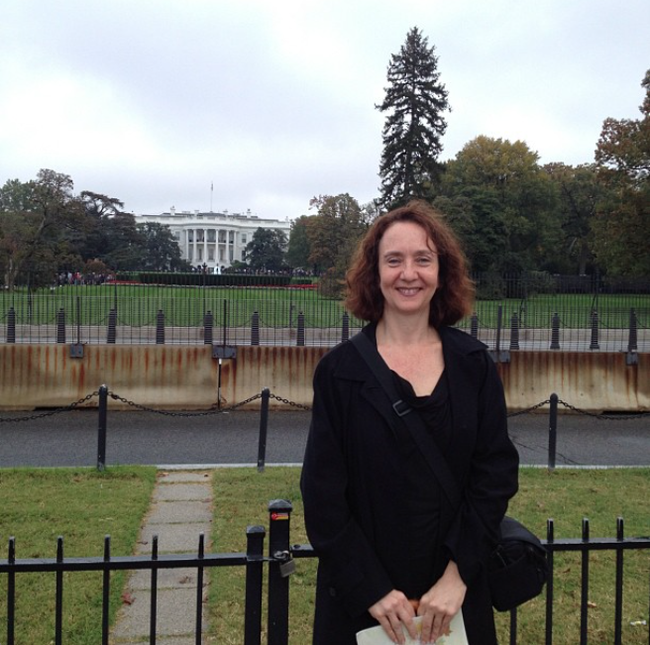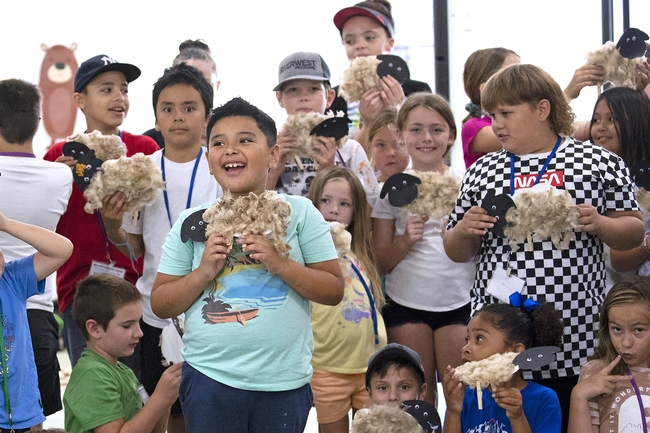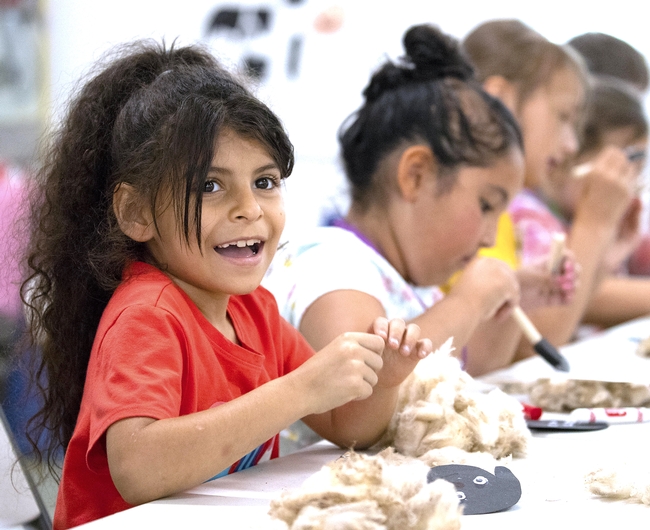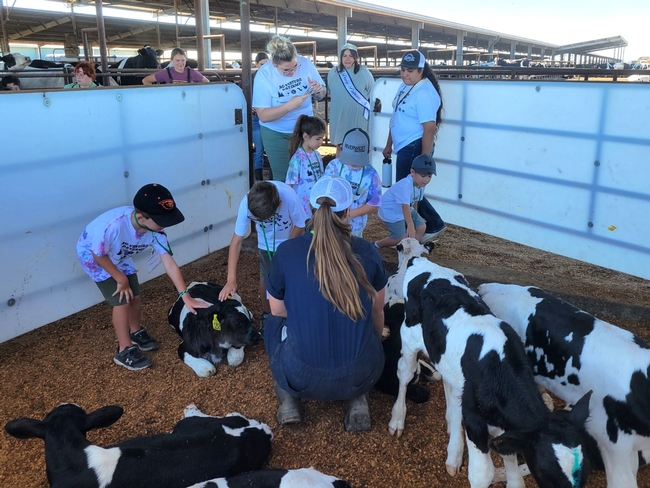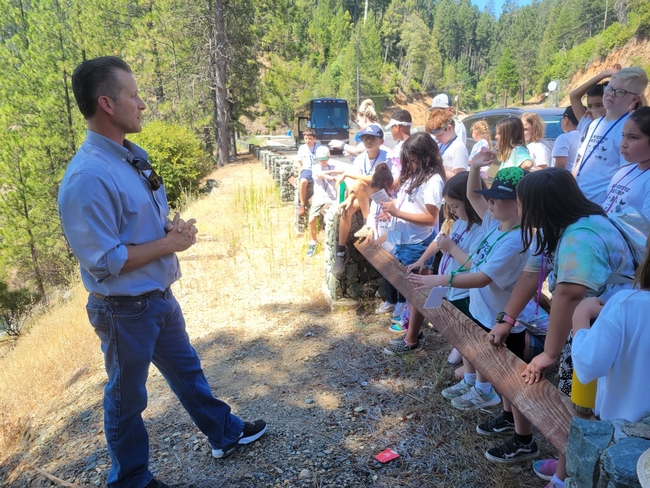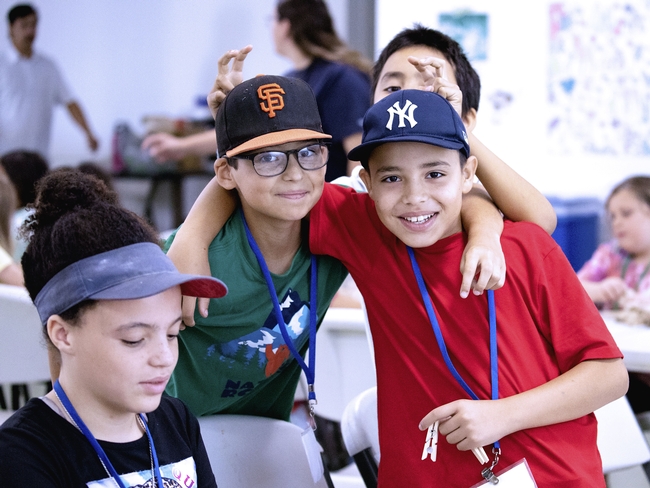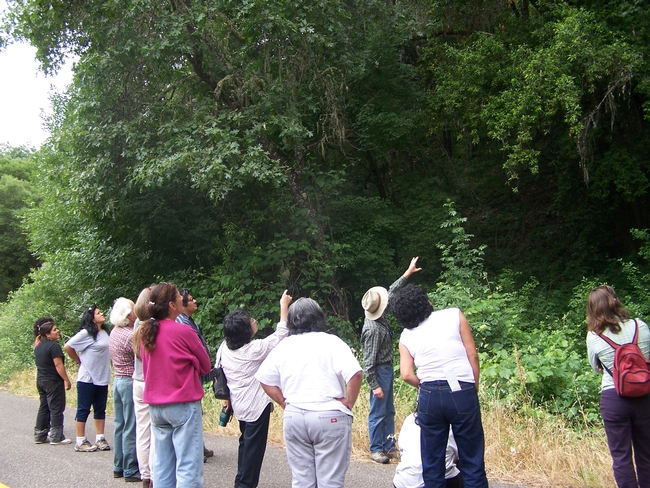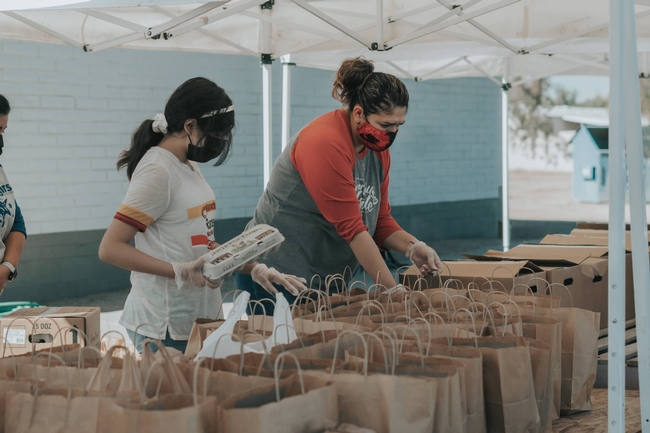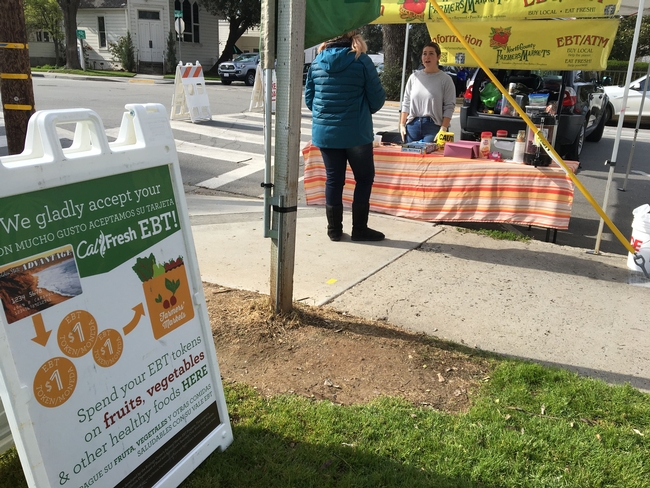Posts Tagged: extension
Rachel Surls has cultivated a healthier LA County through gardens
UC Cooperative Extension advisor who promotes school gardens, urban agriculture to retire after 35-year career
A stroll through a leafy, green garden can give one temporary relief from life's harshness. During her career, Rachel Surls has used gardens to cultivate healthier communities, whether they are growing nutritious food or providing science lessons for students.
Over the past 35 years, Surls, University of California Cooperative Extension sustainable food systems advisor in Los Angeles County, has witnessed many changes – such as promoting public events on Instagram rather than typing and mailing press releases. A comforting and consistent presence has been the UC Master Gardener Program, part of UC Agriculture and Natural Resources.
“As I look back, the UC Master Gardener Program has been a constant in my work. It helps so many people,” said Surls, who joined UCCE as a school and community garden coordinator in 1988.
“My new job with UCCE-LA was my dream job. I organized community gardens around the county and supported teachers who wanted to start school gardens,” recalled the Michigan native, who plans to retire at the end of the year. “I had a bachelor's degree in agronomy and was freshly out of a stint with the U.S. Peace Corps in rural Honduras. My work there inspired me to pursue community development work related to gardening.”
Louisa R. Cardenas, trustee of Los Angeles County Natural History Museums, was a UC Master Gardener volunteer for 25 years.
“Among Rachel's many skills and assets are her willingness to listen to and consider ideas from Master Gardeners that eventually reach and empower Los Angeles County residents to grow food that supplements their nutritional needs,” Cardenas said.
To complement the nascent UC Master Gardener Program in Los Angeles County, Surls organized “Gardening Angels,” a cadre of volunteers to work with teachers and students to develop school gardens. She edited a guide for teachers, parents and volunteers to build gardens for children.
“I met Rachel in 1992 and was so blessed to come up through the ranks with her,” said Rose Hayden-Smith, UCCE emeritus advisor in digital communications in food systems and extension education. “We were in neighboring counties, and had many similar programmatic interests, including school gardens. Her research informed my work and was so helpful to me.”
Advancing food security, community nutrition
In 1994, after earning her master's degree from Cal Poly Pomona in agricultural science with a focus on agricultural education, Surls accepted a newly created position: UC Cooperative Extension urban horticulture advisor.
To retain Los Angeles County funding in 1992, the UCCE staff had become part of the county's Housing Authority/Community Development Commission. As the UCCE urban horticulture advisor, Surls was tasked with developing gardens at five public housing sites. At one of these locations, Carmelitos Housing Development in Long Beach, she worked with community partners to select landscape trees, hire a greenhouse contractor and design a horticulture job training program for public housing residents. This site became known as the Growing Experience Urban Farm.
“I'm pleased that 29 years later, the Growing Experience is still an active community farm where UC Master Gardeners offer workshops for the community,” Surls said.
In 1997, when George Rendell retired as director of UCCE in Los Angeles County, Surls applied for the job. For the next 14 years, she oversaw more than 70 employees and local programs, including the 4-H youth development program, which launched afterschool, hands-on learning for children.
Surls, who participated in 4-H herself as a child, worked closely with 4-H funders. She helped secure grants, contracts and gifts for 4-H as well as the UC Master Gardener Program and UCCE nutrition programs for projects that encouraged Angelenos to eat more fruits and vegetables.
“Rachel was incredibly creative and innovative as a leader,” said Hayden-Smith, who served as director of UCCE in Ventura County. “Rachel models a kind of quiet leadership that invites people into the process, honors the group and moves work forward in important ways.”
While working, Surls earned her Ph.D. in higher education administration at Claremont Graduate University in 2008, with an eye on pursuing other leadership roles. Instead, the global financial crisis inspired her return to working directly with Los Angeles County residents on urban gardening to reduce food insecurity.
To focus on outreach, the UCCE sustainable food systems advisor handed her UCCE director duties to Keith Nathaniel, UCCE 4-H advisor, at the end of 2011.
Developing, sharing resources for urban farming and gardens
In 2012, she organized colleagues within UC Agriculture and Natural Resources and community partners to study the needs of urban farmers and begin offering workshops for them. She led the development of an urban agriculture website, with resources covering business management, food safety, marketing and regulations. She served on the leadership board of the Los Angeles Food Policy Council and began advising cities on policies that would make it easier for residents to grow food.
“These have been my favorite and most productive years of my career,” Surls said.
Drawing on skills she began honing as an undergraduate at Virginia Tech as a news writer for the Virginia Extension Service, Surls co-authored a book about the history of agriculture in Los Angeles County, called “From Cows to Concrete: The Rise and Fall of Farming in Los Angeles.” She is currently working on a second book about urban farming in the U.S.
The Grow LA Gardens Initiative – which helps aspiring gardeners start their own gardens quickly – is one source of pride for Surls. Hundreds of people have taken the four-week course and, after participating, nearly 70% planted gardens.
In 2018, Surls was honored with the Bradford-Rominger award by the Agricultural Sustainability Institute at UC Davis for her work promoting community gardens, school gardens and urban agriculture.
With community gardens and school gardens now commonplace, Surls chuckles as she recalls veteran UCCE colleagues advising her to choose a more “serious” academic focus early in her career.
“It's gratifying to see so many people in academia working on farming in cities, school gardens and community gardens,” Surls said.
Advocating for equity
In 2022, while Surls was on sabbatical, she and Cardenas – the longtime UC Master Gardener volunteer – requested and received $100,000 from the Los Angeles County Board of Supervisors to hire an equity, diversity and inclusion coordinator and to fund outreach. This UC Master Gardener project championed by Supervisor Sheila Kuehl specifically reaches underserved populations within the county. “Such a significant achievement would not have been possible without Rachel's encouragement and support,” Cardenas said.
After she retires, Surls plans to volunteer her expertise for online training of UC Master Gardener volunteers statewide. To support their program efforts including outreach to the Spanish-speaking community and scholarships for underserved communities, Surls has pledged to give $5,000 as a matching gift to donations to the UC Master Gardener Program in Los Angeles between Giving Tuesday, Nov. 28, and Dec. 31 at https://ucanr.edu/LAmastergardener.
Ag-Venture campers dive ‘head first’ into agriculture, natural resources
UC Cooperative Extension team in Sutter and Yuba counties showcases UC ANR programs, community partners
When dozens of elementary schoolers gathered to watch a live calf birth at Tollcrest Dairy in Yuba County, their comments ranged from “disgusting but cool” to “I saw something that maybe I'm too young to see.”
Expanding horizons, growing knowledge and gently pushing some limits were at the heart of a four-week day camp, Ag-Venture, organized by the University of California Cooperative Extension office serving Sutter and Yuba counties.
Throughout July, more than 80 campers – ages 5 through 12 – explored agriculture and science topics through field trips across the region, hands-on activities and lively presentations by UCCE advisors, UC Master Gardeners, 4-H specialists, UC Master Food Preservers and CalFresh Healthy Living, UC educators. All these groups fall under the umbrella of UC Agriculture and Natural Resources.
A grant from The Center at Sierra Health Foundation funded this day camp for underserved youth focused on agriculture and natural resources – the first of its kind in the area. Exploring the themes of “Interesting Insects,” “Foods and Farms,” “Woods and Water” and “Awesome Animals,” the campers learned directly from community experts and UC ANR scientists.
“Some of the kids might think scientists are only wearing lab coats and working with genetics and DNA and human-based science, but here they got to see agricultural scientists and natural scientists,” said Rayna Barden, the 4-H community education specialist who led the camp. “It was a cool way to showcase what ANR does and what we have to offer.”
Youth gain wide range of experiences, knowledge
Visits to local farms and ranches – with many chances to greet the animals – were a highlight for many of the camp participants.
“I liked learning about agriculture and the interactive activities,” said a fourth grader. “I saw a baby cow coming out of its mama, and they [farm staff] had to use a tool. It was cool.”
A sixth grader said: “I learned that feed is made up of everyday items, like almond shells and beer hops!”
“Sheep, cows and goats have one stomach and four chambers,” added another sixth grader.
That digestive tidbit was absorbed by the campers after a visit with UCCE livestock and natural resources advisor Dan Macon at Sierra Foothill Research and Extension Center, a facility operated by UC ANR in Browns Valley.
“We have 4-H kids and FFA kids in high school who still don't know how the four chambers work!” Barden said. “These kids had it and it was so cool to see that they remembered that from a previous day.”
Time and time again, Barden said she was amazed at how much the campers retained. After a visit to Bullards Bar Reservoir, a seven-year-old was able to explain why the dam is curved. Another young boy could draw his own interpretation of the water cycle. And several campers talked about the rice presentation for weeks.
Whitney Brim-DeForest, UCCE county director for Sutter and Yuba counties and a rice advisor, had the participants touch and feel different rice seeds and varieties. The campers also got to plant a few rice seeds to take home.
“But their favorite part – and what they talked about for the rest of camp – was the tadpole shrimp,” Brim-DeForest said. “We brought some live and preserved specimens, and they loved them!”
Sparking ideas for future careers
One third-grade camper said she enjoyed learning the differences between agricultural pests and beneficial insects.
“And you can do stuff to help the good bugs,” she said, adding that she would like to pursue a career working with animals and nature.
Expanding awareness among young people of new career possibilities was exciting for Ricky Satomi, UCCE forestry and natural resources advisor for Sutter and Yuba counties. Using interactive exercises (such as those developed by California Project Learning Tree, another UC ANR-affiliated program), Satomi shared his knowledge about resource competition, watershed filtration and fire behavior in forest ecosystems.
“It's always a pleasure to introduce students to the natural resources where they live,” Satomi said. “This is particularly critical given the current workforce shortage we face in forestry; I hope their experience at Ag-Venture will spark interest in future forestry careers, where these students can work to better their local forest communities.”
Young people from local colleges and universities also gained invaluable experience during the camp. Four students helped prepare the camp: Yasmeen Castro Guillen (Chico State), Alana Logie (Yuba College), Jayla Pollard (Folsom Lake College) and Adam Yandel (Chico State). Three more helped lead the camp as counselors: Hector Amezcua (Yuba College), Alyssa Nott (Butte College) and Jillian Ruiz (Chico State).
“They did such a fantastic job, mentoring the kids and serving as positive role models, and we have seen tremendous growth in all of them, too – in confidence, skills and knowledge,” said Brim-DeForest.
A true community effort
Barden emphasized that the sweeping scope and in-depth, intertwining lessons of the camp were only possible through broad support from the greater community. Brim-DeForest highlighted the partnership with Yuba City Unified School District, as well as with Sutter County. Camp HQ was in Ettl Hall, a Sutter County building; campers visited the Sutter County Museum; they also met Yuba-Sutter public health officer Dr. Phuong Luu.
Additional collaborators included Melissa Ussery, CalFresh Healthy Living, UC nutrition program supervisor; Rene McCrory, 4-H secretary; Johnny Yang, UC Master Gardener and Master Food Preserver program coordinator; Matt Rodriguez, 4-H youth development advisor; and Nicole Marshall-Wheeler, 4-H youth development advisor.
“Honestly, we could plan all of this, but without the community's support, our program never would have worked smoothly,” said Barden, who grew up in the small town of Sutter. “Having all of our guest speakers, having all the people who were willing to have up to 50 kids on their property – it just shows how much our community is about our youth.”
Brim-DeForest said Sandy Parker, the camp nurse, exemplifies that spirit. A UC Master Gardener and 4-H alumna and volunteer, Parker also invited the campers to her family ranch, where she introduced the children to her farm animals and Great Pyrenees guardian dog.
The campers certainly appreciated the generosity, teamwork and energy that went into Ag-Venture. Barden said that many of the participants originally had only signed up for one or two weeks – but loved the camp so much that they asked to register for more. And she added that the “vast majority” of them said they want Ag-Venture to come back and would attend in the future.
“Our youth are just so resilient and so willing to learn,” Barden said, reflecting on the camp overall. “Whereas adults, we're usually a little more timid at things, these kids just were willing to dive in, head first, and be in that moment and try to take away as much as they could from what they were offered there at camp.”
Tribal Engagement at the Hopland Research and Extension Center
The Hopland Research and Extension Center is situated on the traditional, ancestral and unceded lands of the Shóqowa and Hopland People, whose historical and spiritual relationship with these lands continues to this day and beyond (for more on the Land and people history of the site, see this story map). It was, and continues to be, difficult for Indigenous people to thrive in the Shanél Valley after they were forced off the fertile land and had to resettle on relatively small upland parcels and away from freshwater sources. UC ANR staff and academics at the Hopland Research and Extension Center are working to build relationships with the Hopland Band of Pomo Indians who live and work next door at the Hopland and Nacomis Rancherias.
Hopland REC Director John Bailey is committed to building relationships with the intention of enabling maximum benefits for local tribal communities. Tribal Chairperson Sonny Elliot and the Council have been helping us find ways to collaborate after a long history of distrust and despite the University's founding using the sales of expropriated lands (Land-Grant College Act, 1862) and our continued occupation of California Indian territories. Bailey is working with local tribes to define a newly funded Academic Advisor position to build relationships, advance UC policy around working with Tribes, and restore good fire to the landscape with the help of cultural practitioners.
We have secured funding to hire a Native college student to help revitalize ecocultural wetlands in Hopland this summer. The intern will spend time talking with Indigenous people living within the oak woodland landscape or North Coast California and develop a plan for stewarding ecoculturally important sites at the Hopland Research and Extension Center with the Hopland Band of Pomo Indians and local experts in traditional ecological knowledge. This internship offers an opportunity for a Native American college student or two to learn about wetland systems and traditional ecological knowledge; and share their experience with other tribal community members.
Hunting opportunities for Tribal youth and their families and plant collection sites for basket materials are available. The hope is that more cultural ceremonies can take place where generations of Pomo people spent time near the waterways that span Hopland REC. Finally, together we are exploring ways to modify access of existing roads at Hopland REC to allow for potential emergency evacuation for Rancheria residents.
More to come, we hope.
UC ANR experts offer counsel as CalFresh benefits shrink, participants face hunger
Reduction of SNAP benefit deepens crisis of inflation, high cost of living, low wages
Starting this month, many of the estimated 3 million people in the CalFresh program – California's version of SNAP (Supplemental Nutrition Assistance Program) – will be facing hunger and making difficult decisions to meet their most basic needs. In late March, participants received the last of the pandemic-related emergency aid that significantly boosted their monthly benefits. The reduction varies by household size and income; for example, in April a single-person household could see a drop from $281 per month to $23.
“The emergency food allotments had a tremendous impact in our communities and across the nation,” said Shannon Klisch, academic coordinator for the Youth, Families and Communities Program for UC Cooperative Extension in San Luis Obispo and Santa Barbara counties. “One study estimated that these allotments kept more than 4 million people out of poverty across the U.S. in the last quarter of 2021, and reduced child poverty by 14%.”
SNAP increases during the pandemic made many Californians more food-secure, with some participants reporting that their allotments finally had been enough to feed their families for the month, according to Wendi Gosliner, a project scientist at the Nutrition Policy Institute (a program of UC Agriculture and Natural Resources). But, with the benefit reductions, food insecurity is emerging again as a serious concern.
“It is inconceivable that a nation this wealthy should have so many people experiencing hunger,” Gosliner said. “And here in California, with the high cost of living, ongoing inflation and extreme income and wealth disparities, people are being forced to explore every possible avenue just to feed themselves and their families.”
To help ensure they are receiving the maximum allotment, Klisch recommends that CalFresh participants – especially those who applied during the pandemic and are relatively new to the program – double-check their information.
“If the county doesn't have your most up-to-date information, call your county worker if you've changed your address, if you've experienced decreased income, if your housing costs have gone up, or if you have new expenses – like child or dependent care expenses or medical expenses – these can help you qualify for more CalFresh funds,” she explained.
For families with school-aged children, Klisch said they can stretch their food dollars and promote healthy eating by encouraging their children to eat breakfast and lunch at school through California's universal free school meals, and all families with children under 18 can watch for the next issuance of the P-EBT (Pandemic EBT) card, worth potentially hundreds of dollars.
In addition to these options for food assistance, Klisch pointed to programs that can help people save money on other household expenses, such as California Alternate Rates for Energy Programs (CARE) and Affordable Connectivity Program. Local food banks are also gearing up across the state to handle an expected surge in clients in need of emergency food; a list of California food banks can be found at cafoodbanks.org/our-members.
“We ask a lot of low-income families and workers to navigate and piece together various programs, applications, and benefits when we don't commit to a strong safety net,” Klisch said. “On the other hand, when people have enough money for food, everyone benefits through decreased health care costs and increased economic activity.”
Gosliner also said that people should look into their eligibility for WIC (Special Supplemental Nutrition Program for Women, Infants and Children), as well as the federal Earned Income Tax Credit (EITC) and CalEITC, poverty-alleviation benefits underused by Californians.
“People should make sure they are accessing all the safety net benefits for which they are eligible,” Gosliner said.
Market Match, other nutrition incentive programs can help
Through programs like Market Match, available at about 300 farmers markets across California affiliated with the Ecology Center, CalFresh participants can have their EBT benefits “matched” by their local market (usually up to $10 or $15 per visit).
“People are looking to get creative about how to stretch their food dollars, and Market Match is one way to do that,” said Klisch, who has led UCCE efforts to help promote the program along the Central Coast since 2017.
Striving to expand access to fresh fruit and vegetables and to support local farms, UCCE and CalFresh Healthy Living, UC worked with partners to increase CalFresh redemption at farmers markets in San Luis Obispo and northern Santa Barbara counties.
In 2017, about $48,000 in CalFresh and Market Match benefits were redeemed at farmers markets in the area. In 2022, the total was more than $207,000 – a 327% increase. According to Ecology Center figures for the entire state, CalFresh and Market Match spending at farmers markets jumped 161% from 2019 to 2021, up to $13 million.
Gosliner, whose research has shown that these nutrition incentive programs are associated with increased food security, noted that “the people who use Market Match absolutely love the program and feel it is incredibly helpful.” She also added that the California Department of Social Services is developing a pilot program that would offer match incentives for purchasing fruits and vegetables at larger food retailers.
Although the biggest of its kind, Market Match is just one of the programs across California that provide “matches” for healthy food purchases under the California Nutrition Incentive Program, which in turn is primarily funded by GusNIP (the nationwide Gus Schumacher Nutrition Incentive Program).
GusNIP dollars – and SNAP overall – are governed by the federal Farm Bill, typically renewed every five years and currently being negotiated by Congress.
Fewer than 10% of patients screened for food insecurity during pandemic
Study finds even fewer screened during virtual appointments
As jobless rates rose during the COVID-19 pandemic, millions more Americans experienced food insecurity because they lacked consistent access to food. National health organizations recommend primary care providers screen patients for food insecurity, since not having access to enough food can lead to chronic diseases.
But research from the University of California, Davis, finds that only 7% of primary care providers screened patients for food insecurity. If the appointment was virtual or telehealth, only 3% asked patients about their access to food. The American Journal of Preventive Medicine published the research.
“These rates are surprising and seem relatively small in comparison with what seems like a growing awareness of food insecurity during the pandemic,” said lead author Cassandra Nguyen, an assistant professor of Cooperative Extension in the UC Davis Department of Nutrition.
She said the findings may indicate that health care providers were prioritizing emergency responses to COVID-19. The research showed that once people had access to COVID-19 vaccines, screening for food insecurity increased to 10%.
Barriers to telehealth screenings
Screening for food insecurity at telehealth appointments remained low even after vaccines became available. Nguyen said that may suggest telehealth appointments have unique barriers.
“One of those barriers could be a concern about privacy and whether the patient is alone or feels comfortable discussing a potentially stigmatizing experience such as food insecurity. This may deter a primary care provider from asking about it,” Nguyen said.
Screening might also be more difficult if patients aren't familiar with the technology needed or if there are technological disruptions during telehealth appointments. Nguyen said more study is needed about potential barriers given the increased popularity of telehealth appointments since the pandemic.
The research examined electronic health records and clinic data from a national network of more than 400 community health centers in 16 states. It examined encounters between March 11, 2020, and Dec. 31, 2021. Screening typically involves a primary care provider asking the patient to answer that either or both of the following two statements is often true or sometimes true:
- Within the past 12 months we worried whether our food would run out before we got money to buy more.
- Within the past 12 months the food we bought just didn't last and we didn't have money to get more.
Co-authors include Rachel Gold with OCHIN Inc. and Kaiser Permanente Northwest Center for Health Research; Alaa Mohammad, Dedra Buchwald and Clemma Muller with Washington State University; Molly Krancari, Megan Hoopes and Suzanne Morrissey with OCHIN Inc.
The National Center for Advancing Translational Sciences of the National Institutes of Health, and the National Institute of Diabetes and Digestive and Kidney Diseases supported the research.

